Module 5: Nouns, Adjectives, and Related Stuff
Module 5: Advanced Unit
NOUNS, ADJECTIVES, AND RELATED STUFF
Contents of Advanced Unit:
1. Thinking through complex NPs
We’ve now seen noun phrases with several different kinds of internal constituents: nouns, pronouns, determiners, adjectives, and prepositional phrases. Let’s use this knowledge to think through the structure of some more complex NPs. Consider the following:
How do you think you would draw a tree for this NP? This question is really: How would you analyze the relationships between all of the elements inside of this large NP?
It’s always good to start with labeling the words in a phrase (or sentence). Fill in the blanks before proceeding:
Now let’s start to think about the internal structure of the NP. Given how many words there are, some of them probably form smaller phrases—perhaps NPs within the larger NP. Notably, there are two prepositions: of and about. What does this mean? If you said, “there are also two prepositional phrases,” you are correct!
Let’s start on the right-most side of the phrase: English tends to “add things on” in a leftward fashion, with the head of the phrase on the right–though this is NOT always true, as we’ve already seen with PPs where the head is the leftmost item. But it often helps to start on the right side.
Since about is a preposition, you know that it will be the head of a PP. What is its object? The noun healthcare. This gives us:

Now, if you know that about healthcare is a PP, you also know that it must be “connected” to some other element in the phrase. What does about healthcare have a relationship to? It tells which bill is being discussed: we are talking about a bill about healthcare. So we can attach this PP to the head noun bill and have:
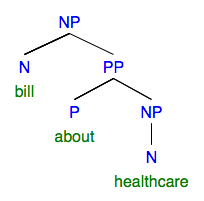
However, this NP is actually not finished yet: which bill about healthcare? THIS bill about healthcare. There is a determiner, this. To accommodate this we can use our N’ (N-bar) notation for an intermediate phrase level:
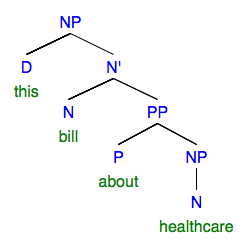
We’re halfway there! What is the relationship of their first draft of to this bill about healthcare? Well, of is a preposition, therefore it should be the head of a PP. What is its object? The NP this bill about healthcare! Make the tree:
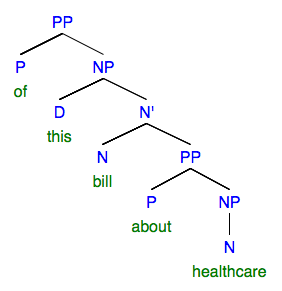
Now, what is this PP connecting to? I’ll go ahead and draw out the rest of the phrase for you, with two options. What’s the difference in what these two trees are “saying” about the structure of this phrase?
Here’s the first tree:
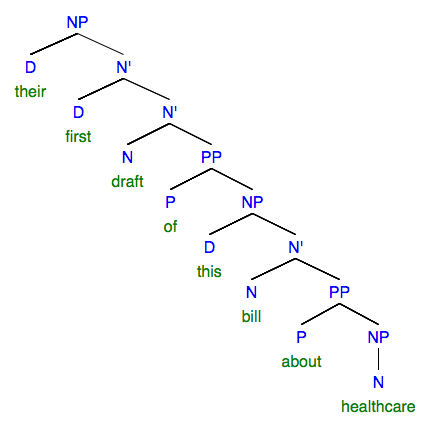
In this case, we are saying there’s a draft of this bill about healthcare; it’s the first of such drafts; and, it’s their first draft of the bill.
One thing you might question with this would be whether [draft of this bill about healthcare] is really the right unit to be specified by first. Is it the [first] [draft of this bill about healthcare], or is it the [first draft] [of this bill about healthcare]? I think either of these is a sensible position; it depends on how you think your brain works!
If you prefer the latter, then go with this tree:
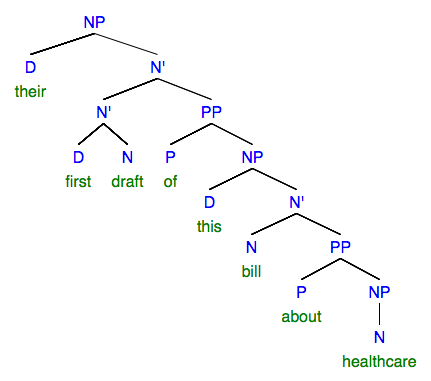
You should be able to understand and explain the differing internal structures being claimed by these two trees.
Try your hand at these phrases. Draw the trees!
his box-office smash movie about aliens
behind the scenes of the hit film of the summer
These are partly complex because of the presence of one or more PPs within the NP.
But there are other ways in which an NP can be more complex. What’s going on with each of these?
my very cool toddler
super exceedingly adorable voice
Each of the two above phrases contains not just an adjective, but additionally an adverb modifying the adjective: [very cool] and [super exceedingly adorable]. We’ve seen AdjPs like this before, of course! I would draw these adjective phrases as so:
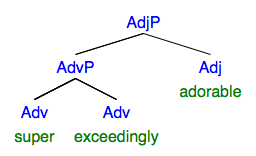
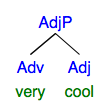
And these would then each modify their head nouns; toddler and voice:
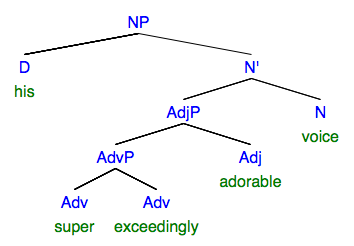
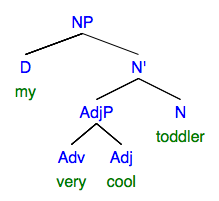
One other way that NPs could be more complex is by the presence of a whole clause inside! In each of the following, the underlined constitutes one NP.
I loved the song he wrote for me.
Songs that have a catchy melody are irresistible.
It’s always the ones you least expect to like that you eventually end up loving.
We’ll talk more about these kinds of things later!
2. Test Yourself: Quiz for Module 5, Advanced Unit
Complete before moving on to the next unit!